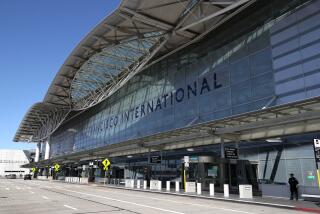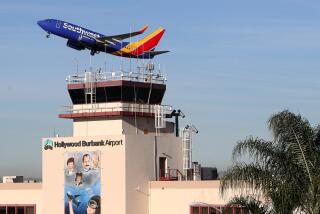A drive to save Tempelhof Airport, base of the Berlin airlift
- Share via
BERLIN — Gabriele Leech-Anspach was a young mother with a toddler when Soviet authorities suddenly imposed a blockade on West Berlin in 1948, cutting off all road, train and boat access and leaving 2.2 million Berliners stranded on an island of the new Cold War.
“I was 29 years old. I had a boy of 2 years. It was very important that he got enough food,” recalled Leech- Anspach, now 89, describing the new anxiety that spread across the city like a cold wind from the East just a few years after a world war had ended.
In what is now considered one of the greatest operations in aviation history, U.S. and British pilots began flying in the first of what would be more than 5,000 tons of supplies daily to Tempelhof Airport, whose grand passenger hall once was considered a temple to Adolf Hitler’s dream of a grand Germania.
For the next 11 months, Leech-Anspach and her family had a steady supply of powdered eggs and milk, canned meat, dried vegetables and cornmeal for “yellow bread,” delivered by planes that touched down at Tempelhof every 90 seconds. They cut wood from the nearby forests to heat their houses. Thanks to the Berlin airlift, they survived.
Today, Berlin residents will go to the polls to vote in a referendum on plans to close Tempelhof, which stands as a majestic relic near the center of a now-united Berlin. City officials say the aging airport, which today serves only a few small regional airlines and private jets, is too expensive and too close to a constantly growing city. Losses are reaching $15.7 million a year.
The city hopes to divert all of Berlin’s air traffic to the huge Berlin-Brandenburg International Airport, scheduled to open 10 miles southeast of the city in 2011.
Rarely in recent years has a civic issue so mobilized the population as the battle for this neglected old airfield, so frozen in time that it looks like Ingrid Bergman might be about to board a DC-3 in the fog out on its grand, canopied tarmac.
The Berlin government, citing noise, crash and pollution hazards with neighborhoods little more than half a mile away, has ordered the facility closed in October.
The nonbinding referendum, if approved, would ask the city government to reverse the closure order and withdrawal of the airport’s license.
Campaign posters advising citizens alternately to “Save Tempelhof” or refuse to continue subsidizing “a VIP airport” are on most street corners, and the pros and cons on the front pages of mass-circulation dailies.
“I think it’s just a reminder of history,” Leech-Anspach said. “Of course, some people say it’s so expensive to keep it in its normal use, because we shall have this big new airport. But there’s so much that has already been destroyed. I think it should remain as a document.”
The campaign group leading the referendum drive gives a nod to history but seems more attuned to Chancellor Angela Merkel’s claim that the airport is good for business.
Like National Airport in Washington, D.C., Tempelhof is convenient for businesspeople on short-haul flights or corporate jets. Parking is readily available just outside the terminal; check-in to boarding takes about 10 minutes.
Business flights will inevitably be squeezed out by big passenger jets for landing slots at the new airport, the campaign organizers predict, while Tempelhof’s cachet as a functioning airport could attract new businesses to repopulate its huge, mostly empty buildings.
Two U.S. investors have proposed leaving the airport in place while converting the terminal building into a $550-million medical, research and commercial network centered on a large healthcare facility.
Perhaps ironically, those who want to close the airport are pushing hardest to preserve its history, as the place where war-ravaged Germans came to see the U.S. and Britain as liberators and friends.
City officials, with backing from several citizens and environmental groups, have proposed turning the storied terminal building into a museum of the Berlin airlift, while converting the huge tarmac and greenbelt behind it possibly into parks or some other public use, along with perhaps a small number of homes and businesses on the perimeter.
“It has been neglected by the city government. Until now there has been no real connection to the history of this place. And now we’re thinking about how we can give this history a real future,” said Tilmann Heuser, spokesman for the German Federation for Environment and Nature Protection.
Tempelhof’s history, like that of some other remnants of prewar Germany, is so grand that it can be a bit uncomfortable.
A monument to National Socialist architecture constructed in the neoclassic style from 1934 to 1941, Tempelhof’s terminal is still one of the largest buildings in the world. The carved eagles at its entrance no longer clutch swastikas, but the towering vertical space inside remains intimidating for mere weekend holiday-makers.
Designed by Ernst Sagebiel as part of chief Hitler architect Albert Speer’s plan for the reconstruction of Berlin, the building was erected on an airfield where Orville Wright gave an air show in 1903. The new facility was intended to become a gateway to Europe and a symbol of Hitler’s “world capital.” Instead, it became a prototype for modern airports around the world.
The roof was large enough to hold 100,000 people who, it was planned, would assemble to watch military parades and air shows.
A towering canopy was extended over the tarmac to allow passengers to board planes in comfort during inclement weather.
These days, the terminal building is a vast, echoing hall with a few airline desks along each side and a snack bar at either end. One company offers tourists scenic flights of Berlin in a DC-3, the civilian version of the military C-47s that made many of the Berlin airlift flights.
Last year, the airport served just 350,000 of the 13 million passengers who flew into Berlin, most of them using the also-to-be-closed Tegel International Airport or a small facility near the future international airport site.
The referendum needs at least 600,000 votes, a quarter of the city’s registered voters, to pass. Even if it does, it will not force the city to reverse the closure order.
But proponents hope it will provide the political force to keep Tempelhof operating at least until the new international airport opens in 2011. They believe crowding at the new facility will convince officials to keep Tempelhof open permanently.
A new poll commissioned by Tempelhof advocates showed 63% in favor of keeping the airport open and 21% in favor of closing it.
“Politics is supposed to be about doing what the people say,” said Andreas Peter, who is leading the pro-referendum group that hopes to keep Tempelhof as a functioning airport. “We believe the Berlin city government is going to listen to its own citizens.”
More to Read
Sign up for The Wild
We’ll help you find the best places to hike, bike and run, as well as the perfect silent spots for meditation and yoga.
You may occasionally receive promotional content from the Los Angeles Times.






